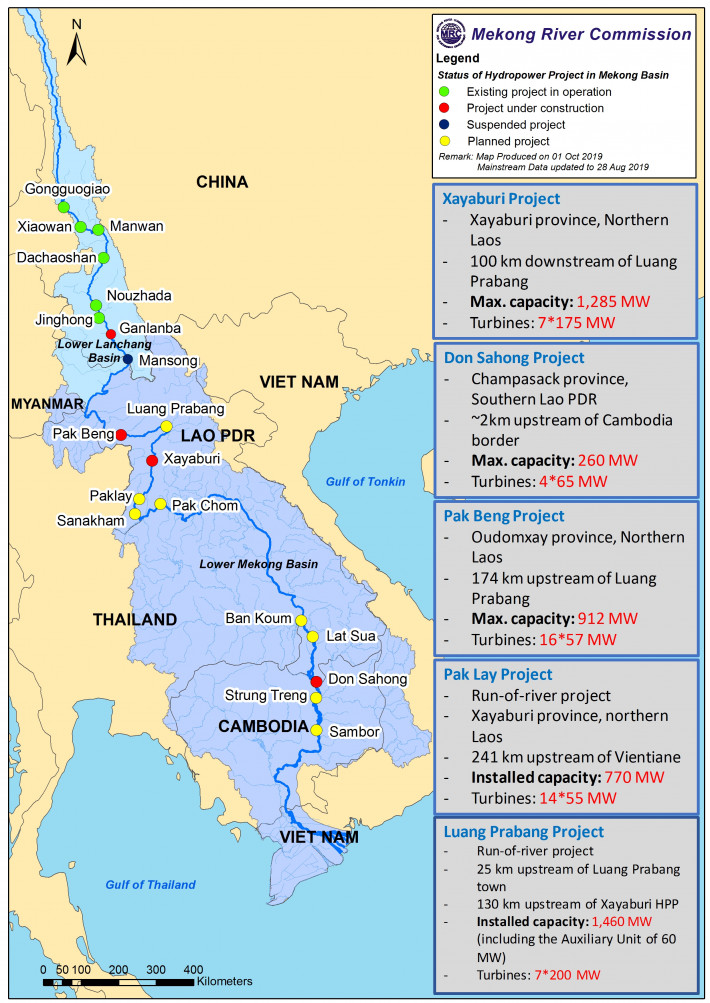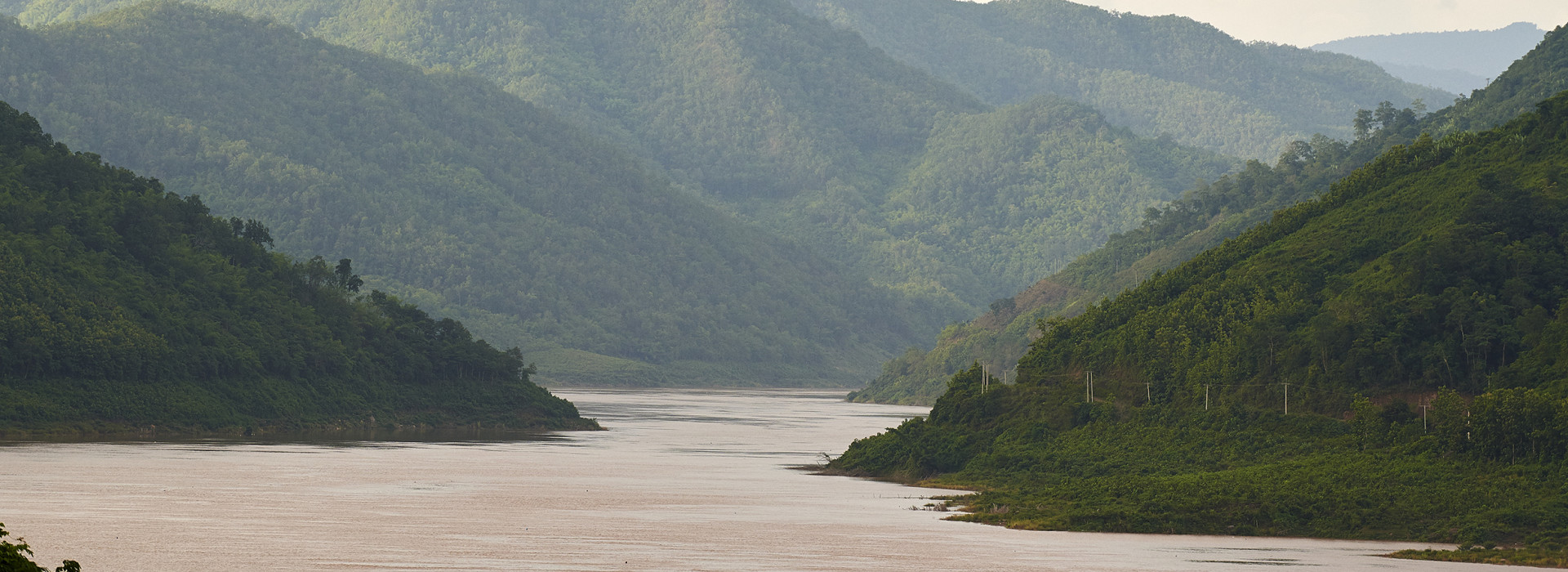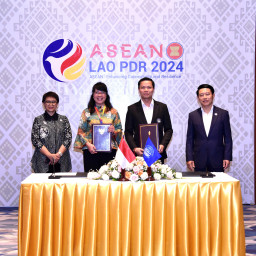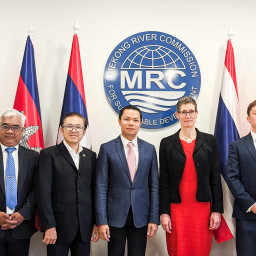Laos to undertake prior consultation for Luang Prabang hydropower project
Vientiane, Lao PDR, 1 October 2019 — The Lao Government will undertake the Mekong River Commission’s prior consultation process for the Luang Prabang hydropower project located between the proposed Pak Beng project on the upstream and the nearly completed downstream Xayaburi project. The run-of-the-river dam will operate continuously year-round and produce 1,460 MW of electricity.
In its notification submitted to the MRC Secretariat on 31 July 2019, the Lao Government says the project’s construction is expected to begin in 2020 and finish in 2027, the year the commercial operation is also set to begin. The generated energy may be sold to Thailand and/or Viet Nam.
“With this submission for prior consultation, the Lao Government fulfills its obligation under the 1995 Mekong Agreement. The submission will enable the notified Member Countries and members of the public to have detailed information and study the project’s water use and any impact stemming from this,” says Dr. An Pich Hatda, CEO of the MRC Secretariat.
The prior consultation is part of the MRC’s procedural rules on cooperation on water use of the Mekong mainstream: Procedures for Notification, Prior Consultation and Agreement (PNPCA). Under the Procedures, any infrastructural project using the mainstream water during the dry season within the same basin, as well as during the wet season between two basins, must undergo the prior consultation process. Applicable projects include large-scale irrigation and hydropower development which may cause significant impacts on the environment, water flow and quality of the Mekong mainstream.
In the prior consultation process, with technical and administrative support from the MRC Secretariat, the MRC’s governing body Joint Committee (JC) will review technical aspects of the project, assess any potential transboundary impacts on the environment and livelihoods along the riparian communities, and suggest measures to address those concerns. The JC aims to come to an agreement on how the consulted case should proceed.
The prior consultation process normally lasts six months, but could be extended further by the JC. It is not meant to approve or disapprove the proposed project.
“The working and continual improvement of the MRC’s PNPCA process is seen around the world as an example of international water law in action,” Dr. Hatda says.
In the notification, Lao PDR provided the technical feasibility study, including the project’s environmental and social impact assessments, cumulative and transboundary environmental impact assessment, environmental and social management and monitoring plans, a resettlement development plan, and engineering documents.
According to MRC procedures, after the submission, the MRC Secretariat has to review and verify the completeness of the submitted documents against the prior consultation procedures during the allowable timeframe given by the PNPCA. With the completion of the initial document verification, the Secretariat has forwarded all the submitted documents to the other three notified countries for their review and has now made them, along with supplementary project overview and communication materials, available on the MRC website to facilitate a more meaningful consultation process.
“We’re ready to facilitate discussion, provide science-based and objective views and further submit any recommendations on the proposed project to the Joint Committee,” says Dr. Hatda. “We’re also committed to maintaining the same level of openness and transparency to the public throughout the process. Regardless of one’s views on the project, I invite everyone who cares for the future of the Mekong River to join and contribute to the discussion, making your voices heard and documented.”

Until now, 48 projects on the Mekong have been submitted for the Notification process under the PNPCA: three projects from Cambodia, 30 from Lao PDR, two from Thailand and 13 from Viet Nam. In addition to the Luang Prabang submission, four other projects including the Xayaburi, Don Sahong, Pak Beng and Pak Lay have so far been proposed on the Mekong mainstream in Lao PDR and thus submitted for the prior consultation process.
The Luang Prabang project is located at the Houygno village of Luang Prabang province, about 25 km from Luang Prabang town or approximately 2,036 km from the Mekong Delta in Viet Nam. The powerhouse barrage will be 275 meters long, 80 meters high and 97 meters wide.
According to the submitted documents, the Luang Prabang Power Company Limited — a company established by the Lao Government and PetroVietnam Power Corporation under their 2007 Memorandum of Understanding — is named as the project developer. But no project’s cost is indicated.
The MRC Joint Committee Working Group (JCWG), whose membership comprises senior technical representatives from Cambodia, Lao PDR, Thailand and Viet Nam and who acts as an advisory body to the MRC’s Joint Committee in implementing the PNPCA, is scheduled to meet on October 8 to discuss key issues around the prior consultation process of the project, including the starting date of the six-month process.
The MRC together with the National Mekong Committee Secretariats will facilitate national and regional consultations to solicit the public views on the case.
Read the news in Khmer, Lao, Thai or Vietnamese.
Note to editors:
The MRC is an intergovernmental organisation for regional dialogue and cooperation in the lower Mekong river basin, established in 1995 based on the Mekong Agreement between Cambodia, Lao PDR, Thailand and Viet Nam. The organisation serves as a regional platform for water diplomacy as well as a knowledge hub of water resources management for the sustainable development of the region.
- END -





